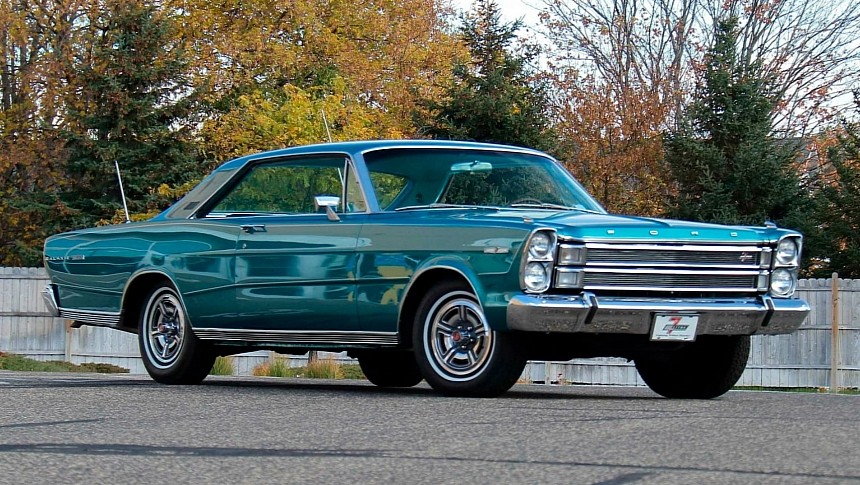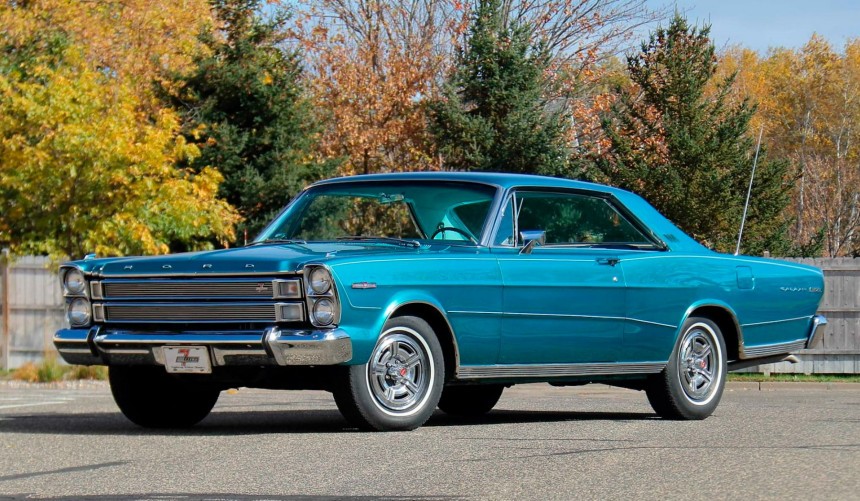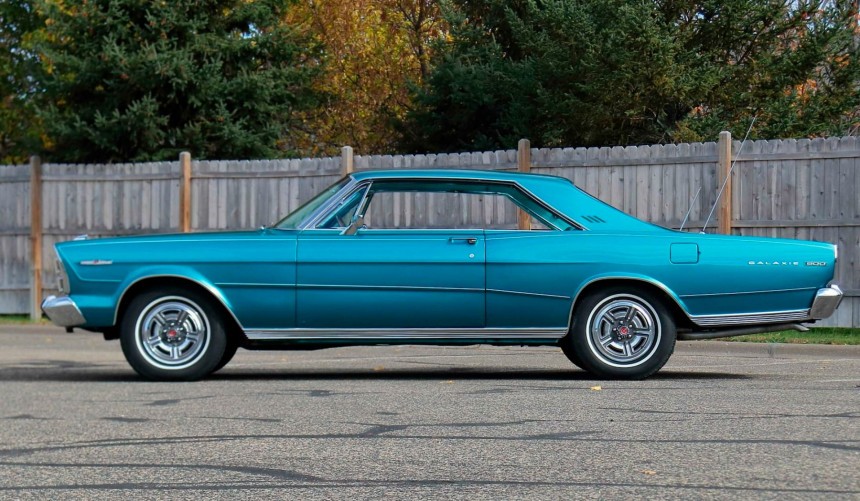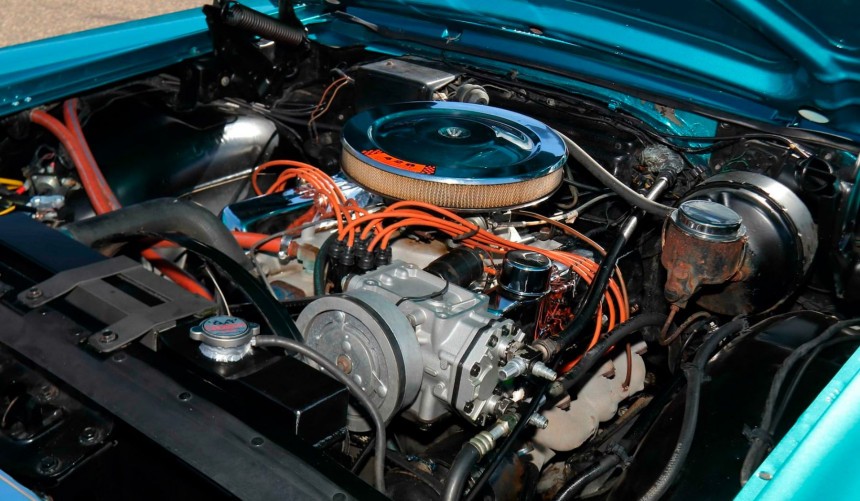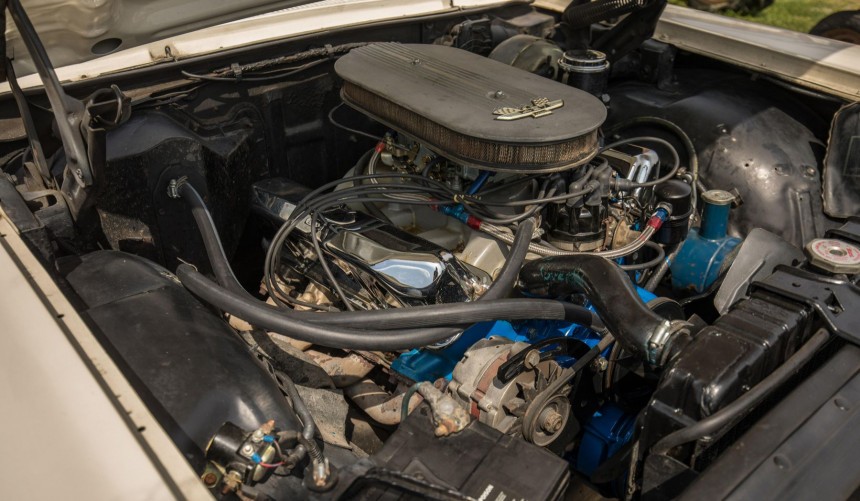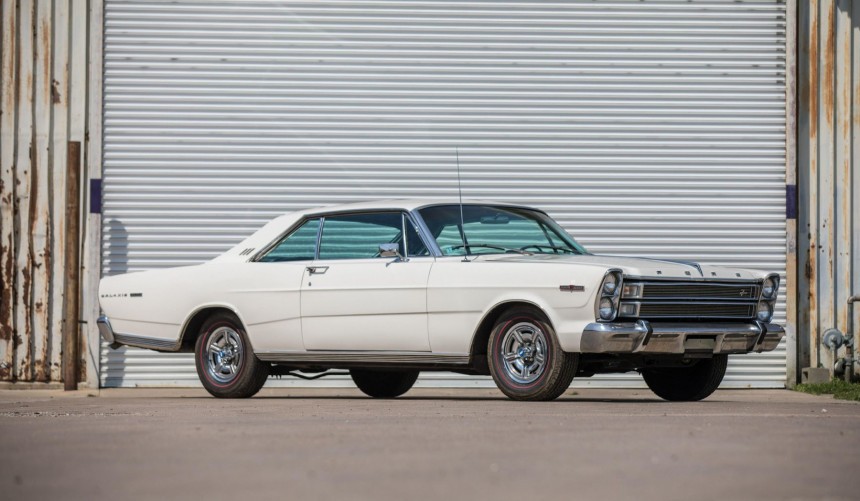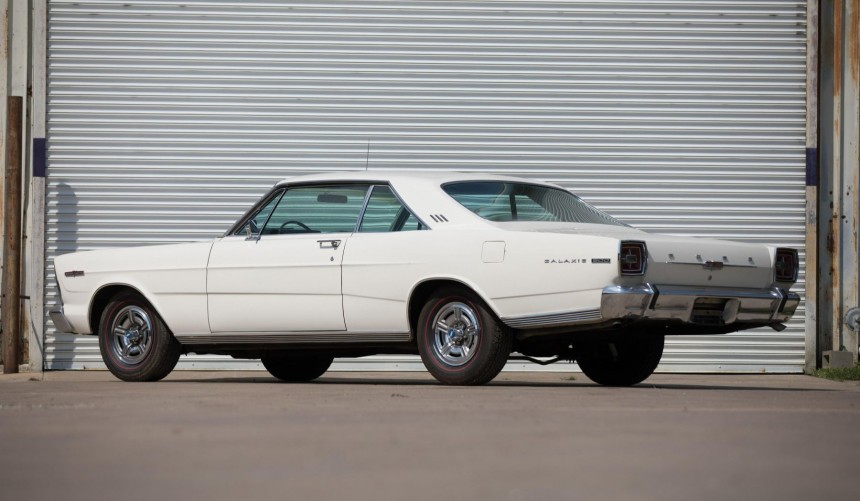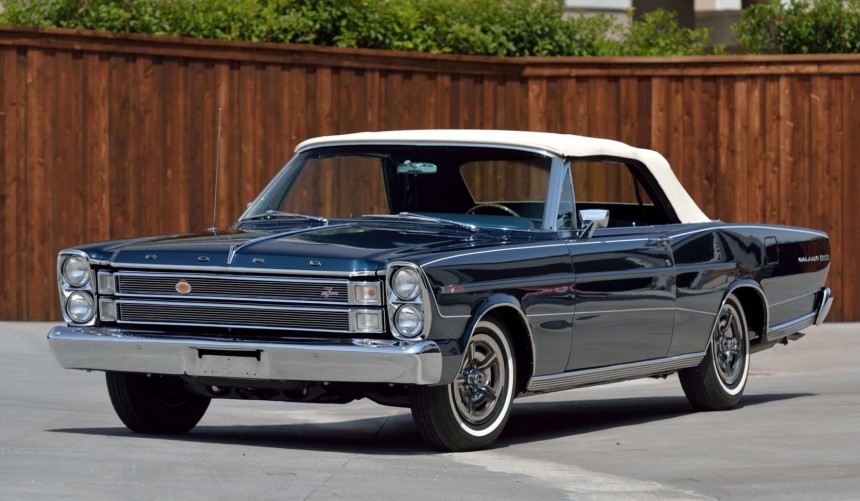Apart from the flashy, high-powered intermediates, pony cars, and compacts, the golden age of muscle cars also gave us some impressive full-size models.
By the mid-1960s, potent big-block V8s were no longer exclusive to trucks or full-size cars. To quench the buyers' thirst for performance, carmakers made them available on smaller platforms, giving birth to some of the most iconic muscle cars.
Nevertheless, most of these engines were still being introduced on the largest passenger car lines before making their way into the engine bays of intermediates, pony cars, and, later, compacts.
That was the case with Ford's 428-ci (7.0-liter) FE V8, first available during the 1966 model year in the corporation's full-size range.
Completely redesigned a year earlier, the standard Galaxie still catered to those looking for a large, comfortable, and affordable passenger car.
But buyers who wanted to add more performance and sophistication to their Galaxies could opt for the range-topping 500 and 500XL models.
With the release of the new 428 engine, Ford added a new model named after the metric equivalent of its displacement.
Though the 428 wasn't exclusive to this new model, nor was it the only 7-liter available in the Galaxie range, the 7-Litre was created specifically to promote the new engine and was the only Ford that offered it as standard equipment in 1966.
Apart from the engine, the new model - available only on the two-door coupe and convertible Galaxies - offered unique badges, a sporty simulated-woodgrain three-spoke steering wheel shared with the Mustang and Fairlane GTs, front bucket seats, a bucket-style rear bench, and a floor console.
With the Galaxie being overhauled a year later, Ford went as far as comparing its full-size model to the era's Rolls-Royce cars - at least in terms of smoothness and quietness of the suspension assembly.
But, for the sporty 7-Litre's suspension, smoothness and quietness were no longer prime objectives. Engineers focused on improving performance, adding extra heavy-duty shock absorbers and springs, plus a heavy-duty front roll bar to reduce body roll and enhance handling.
The list of standard chassis upgrades also included power-assisted front disc brakes with four-piston Kelsey-Hayes calipers and larger rear drums.
With a new standard engine and nearly all of Ford's available premium features offered as standard equipment, the 7-Litre was the finest Galaxie one could buy in 1966, surpassing even the 500XL in terms of sophistication.
With hydraulic lifters, a 480-cfm four-barrel carburetor, and a 10.5:1 compression ratio, the 345-hp 428 (officially dubbed Thunderbird 7-Litre V8) was the unquestionable highlight of the 7-Litre. Nevertheless, it wasn't the only V8 available on the range-topping Galaxie.
While the new engine delivered more low-end torque and felt more civilized, those who wanted a more brutal V8 could opt for the venerable 427.
With solid lifters and a higher compression ratio, this monster was available in two configurations: the 410-hp single four-barrel Q-code and the legendary 425-hp dual-quad R-code.
Gearbox-wise, the 428 came standard with a C6 Cruise-O-Matic three-speed automatic upgraded specifically for the 7-Litre with higher gear ratios.
Buyers who preferred a manual 428-powered Galaxie could get the Toploader four-speed at no extra cost. This transmission was also standard (and the only choice) on 427-equipped cars - which were delivered without air conditioning and power-assisted brakes.
Regardless of the engine choice, the 7-Litre's standard rear end was a 31-spline 9 3/8-inch shared with the era's Lincolns and the Ford F-100. It was available in various open or limited-slip ratios depending on the customer's choice.
Except for minor visual details, the 7-Litre looked like an ordinary Galaxie, but it certainly didn't behave like one, thanks to its chassis upgrades and potent V8 options.
Most performance enthusiasts were (and still are) more drawn to lighter, flashier intermediates, yet for those with a soft spot for land yachts that offered a near-flawless mix between a cruiser and a full-blown performance car, the 7-Litre was the perfect choice.
With the standard 428, the nearly 4,000-pound (1,814 kg) two-door could run the quarter mile in the low 15s, and with the 427, it reached the mid-14-second territory.
While those figures didn't make it the fastest factory-built car available during the 1966 model year, they were still impressive enough to make the 7-Litre a legitimate sleeper.
Despite being an impressive full-size model, the Galaxie 500 7-Litre was far from a sales sensation. Of nearly one million Galaxies that Ford sold during the 1966 model year, only 11,175 donned 7-Litre badges.
Consequently, Ford transformed the 7-Litre from an individual model to a performance package in 1967.
The main reason for the modest sales was the hefty price tag, but fierce competition from performance-oriented full-size models like the Impala SS was also a contributing factor.
Today, the Galaxie 500 7-Litre is often omitted from conversations that revolve around the most impressive full-size models of the 1960s, mainly due to the power potential of its standard V8.
However, many seem to forget its surprisingly crisp handling, abundance of premium features, and last but certainly not least, its timeless beauty.
Of the 11,175 1966 7-Litres, only a fraction have survived. Finding one in good shape is no easy task, but despite that, the value of a 428-powered example that's still roadworthy currently stands around the $25,000 mark.
Of course, there are exceptions. Highly original, low-mileage models can cost twice as much, and convertibles - considerably rarer than hardtops - in similar condition demand even more.
Then there are the 427-powered cars, like the one featured in the YouTube video below by MuscleCarOfTheWeek. Considering that around 35 to 40 were built and only a handful are still around, their value can go into six-figure territory.
Though it was never the fastest nor the most potent full-size model built during the golden age of muscle cars, the 1966 Galaxie 500 7-Litre was one of the most impressive.
Still underrated, it's an affordable classic for those looking for a rare full-size sleeper from the American automotive industry's most exciting era.
Nevertheless, most of these engines were still being introduced on the largest passenger car lines before making their way into the engine bays of intermediates, pony cars, and, later, compacts.
That was the case with Ford's 428-ci (7.0-liter) FE V8, first available during the 1966 model year in the corporation's full-size range.
Marking the occasion with a new Galaxie 500
But buyers who wanted to add more performance and sophistication to their Galaxies could opt for the range-topping 500 and 500XL models.
With the release of the new 428 engine, Ford added a new model named after the metric equivalent of its displacement.
Though the 428 wasn't exclusive to this new model, nor was it the only 7-liter available in the Galaxie range, the 7-Litre was created specifically to promote the new engine and was the only Ford that offered it as standard equipment in 1966.
The range's most sophisticated member
With the Galaxie being overhauled a year later, Ford went as far as comparing its full-size model to the era's Rolls-Royce cars - at least in terms of smoothness and quietness of the suspension assembly.
But, for the sporty 7-Litre's suspension, smoothness and quietness were no longer prime objectives. Engineers focused on improving performance, adding extra heavy-duty shock absorbers and springs, plus a heavy-duty front roll bar to reduce body roll and enhance handling.
The list of standard chassis upgrades also included power-assisted front disc brakes with four-piston Kelsey-Hayes calipers and larger rear drums.
With a new standard engine and nearly all of Ford's available premium features offered as standard equipment, the 7-Litre was the finest Galaxie one could buy in 1966, surpassing even the 500XL in terms of sophistication.
The 428 wasn't the only engine available
While the new engine delivered more low-end torque and felt more civilized, those who wanted a more brutal V8 could opt for the venerable 427.
With solid lifters and a higher compression ratio, this monster was available in two configurations: the 410-hp single four-barrel Q-code and the legendary 425-hp dual-quad R-code.
Other drivetrain options
Buyers who preferred a manual 428-powered Galaxie could get the Toploader four-speed at no extra cost. This transmission was also standard (and the only choice) on 427-equipped cars - which were delivered without air conditioning and power-assisted brakes.
Regardless of the engine choice, the 7-Litre's standard rear end was a 31-spline 9 3/8-inch shared with the era's Lincolns and the Ford F-100. It was available in various open or limited-slip ratios depending on the customer's choice.
A legitimate full-size sleeper
Most performance enthusiasts were (and still are) more drawn to lighter, flashier intermediates, yet for those with a soft spot for land yachts that offered a near-flawless mix between a cruiser and a full-blown performance car, the 7-Litre was the perfect choice.
With the standard 428, the nearly 4,000-pound (1,814 kg) two-door could run the quarter mile in the low 15s, and with the 427, it reached the mid-14-second territory.
While those figures didn't make it the fastest factory-built car available during the 1966 model year, they were still impressive enough to make the 7-Litre a legitimate sleeper.
Far from a best-seller
Consequently, Ford transformed the 7-Litre from an individual model to a performance package in 1967.
The main reason for the modest sales was the hefty price tag, but fierce competition from performance-oriented full-size models like the Impala SS was also a contributing factor.
Extremely rare and underrated today
However, many seem to forget its surprisingly crisp handling, abundance of premium features, and last but certainly not least, its timeless beauty.
Of the 11,175 1966 7-Litres, only a fraction have survived. Finding one in good shape is no easy task, but despite that, the value of a 428-powered example that's still roadworthy currently stands around the $25,000 mark.
Of course, there are exceptions. Highly original, low-mileage models can cost twice as much, and convertibles - considerably rarer than hardtops - in similar condition demand even more.
Then there are the 427-powered cars, like the one featured in the YouTube video below by MuscleCarOfTheWeek. Considering that around 35 to 40 were built and only a handful are still around, their value can go into six-figure territory.
Though it was never the fastest nor the most potent full-size model built during the golden age of muscle cars, the 1966 Galaxie 500 7-Litre was one of the most impressive.
Still underrated, it's an affordable classic for those looking for a rare full-size sleeper from the American automotive industry's most exciting era.
